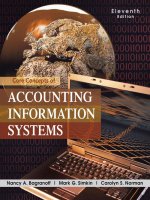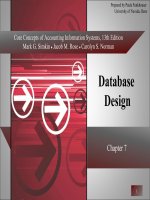Core concepts of accounting information systems 13 by simkin norman chapter 07
Bạn đang xem bản rút gọn của tài liệu. Xem và tải ngay bản đầy đủ của tài liệu tại đây (762.8 KB, 41 trang )
Prepared by Paula Funkhouser
University of Nevada, Reno
Core Concepts of Accounting Information Systems, 13th Edition
Mark G. Simkin ● Jacob M. Rose ● Carolyn S. Norman
Database
Design
Chapter 7
1
Chapter 7: Database Design
• Introduction
• An Overview of Databases
• Steps in Developing a Database Using Resources, Events and
Agents Approach
• Normalization
2
Copyright © 2015. John Wiley & Sons, Inc. All rights reserved.
Introduction
• Uses of a modern AIS
– Systematically record data
– Provide convenient and useful formats
– Easy access to information
3
Copyright © 2015. John Wiley & Sons, Inc. All rights reserved.
What is a Database?
• Collection of organized data
• Used by many different computer applications
• Manipulated by database management systems (DBMS)
4
Copyright © 2015. John Wiley & Sons, Inc. All rights reserved.
Significance of a Database
Critical information
Volume
Distribution
Privacy
Irreplaceable data
Need for accuracy
5
Copyright © 2015. John Wiley & Sons, Inc. All rights reserved.
Significance of a Database
• Internet uses
• Big Data
• Storing Data in Databases
• Data Hierarchy
6
Copyright © 2015. John Wiley & Sons, Inc. All rights reserved.
Storing Data in Databases
Data must be stored and organized
systematically
Three important concepts:
Three important concepts
Data
hierarchy
Record structures
Database keys
7
Copyright © 2015. John Wiley & Sons, Inc. All rights reserved.
Data Hierarchy
• Data organization in ascending order:
– Data field
– Record
– File
– Database
8
Copyright © 2015. John Wiley & Sons, Inc. All rights reserved.
Record Structures
• Data fields in each record of a database table
• Structure is usually fixed
• Example
9
Copyright © 2015. John Wiley & Sons, Inc. All rights reserved.
Database Keys
• Primary Key
– Unique to each record
• Foreign Keys
– Enable referencing of one or more records
– Matches primary key of related table
10
Copyright © 2015. John Wiley & Sons, Inc. All rights reserved.
Records Combined Into Report
11
Copyright © 2015. John Wiley & Sons, Inc. All rights reserved.
Additional Database Issues
Administration
Database
Administrator
Documentation
Includes
a variety of descriptions
Structures,
Data
Contents, Security Features
Dictionary
Metadata
12
Copyright © 2015. John Wiley & Sons, Inc. All rights reserved.
Data Dictionary Example
13
Copyright © 2015. John Wiley & Sons, Inc. All rights reserved.
Additional Database Issues
• Data Integrity
– Data Integrity controls
– Designed by database developers
• Processing Accuracy and Completeness
– Transaction controls
– Ensures accurate transaction processing
14
Copyright © 2015. John Wiley & Sons, Inc. All rights reserved.
Additional Database Issues
• Concurrency
– Concurrency controls
– Prevent multi-user access at same time
• Backup and Security
– Ability to recreate data
– Prevent unauthorized access
– View controls
15
Copyright © 2015. John Wiley & Sons, Inc. All rights reserved.
Study Break #1
The part of the data hierarchy that represents one instance of an
entity is a:
A.
B.
C.
D.
Field
Record
File
Database
16
Copyright © 2015. John Wiley & Sons, Inc. All rights reserved.
Study Break #2
Within the context of databases, the term “concurrency” refers to
the possibility that:
A. A customer of one store might also be a customer of another
store
B. Two database users might want to access the same record at the
same time
C. A credit entry for a customer requires a debit entry for a
matching account
D. None of these
17
Copyright © 2015. John Wiley & Sons, Inc. All rights reserved.
REA Model
• Resources
– Organization’s assets
• Events
– Activities associated with a business process
• Agents
– People associated with business activities
18
Copyright © 2015. John Wiley & Sons, Inc. All rights reserved.
Steps in Developing Databases
with REA
• Identify Business and Economic Events
• Identify Entities
• Identify Relationships Among Entities
19
Copyright © 2015. John Wiley & Sons, Inc. All rights reserved.
Steps in Developing Databases
with REA
• Create Entity-Relationship Diagrams
• Identify Attributes of Entities
• Convert E-R Diagrams into Database Tables
20
Copyright © 2015. John Wiley & Sons, Inc. All rights reserved.
Identify Events and Entities
Types of Events
Economic
Business
• Types of Database Entities
–
–
–
Entities
Agents
Resources
21
Copyright © 2015. John Wiley & Sons, Inc. All rights reserved.
Entity Examples
22
Copyright © 2015. John Wiley & Sons, Inc. All rights reserved.
Identify Relationships
Among Entities
• Types of Relationships
– Direct relationship
– Indirect relationship
• Cardinalities
– Nature of relationships among entities
23
Copyright © 2015. John Wiley & Sons, Inc. All rights reserved.
Cardinality Relationships
Notations
One-to-one
(1:1)
One-to-many (1:N)
Many-to-many (N:N)
Purpose
Occurrence
of one entity
Associated with occurrence of one event of another
entity
24
Copyright © 2015. John Wiley & Sons, Inc. All rights reserved.
Cardinality Relationships
25
Copyright © 2015. John Wiley & Sons, Inc. All rights reserved.









